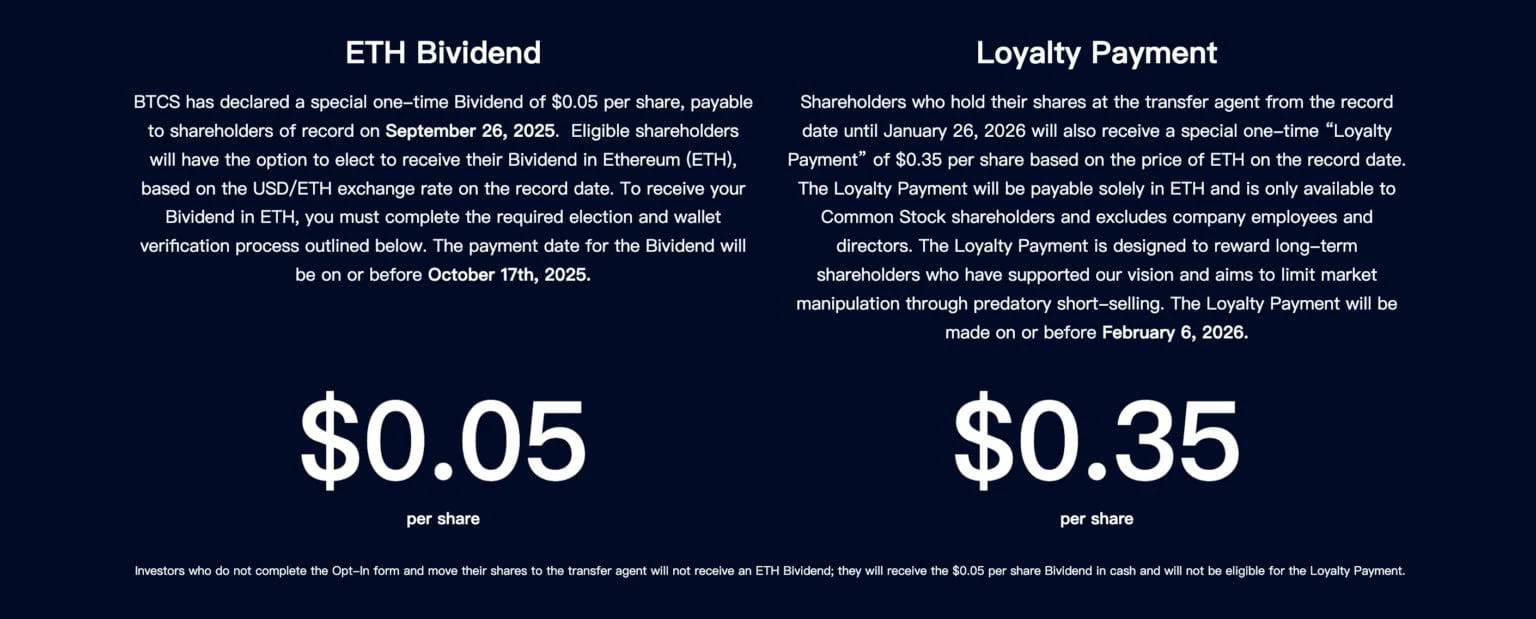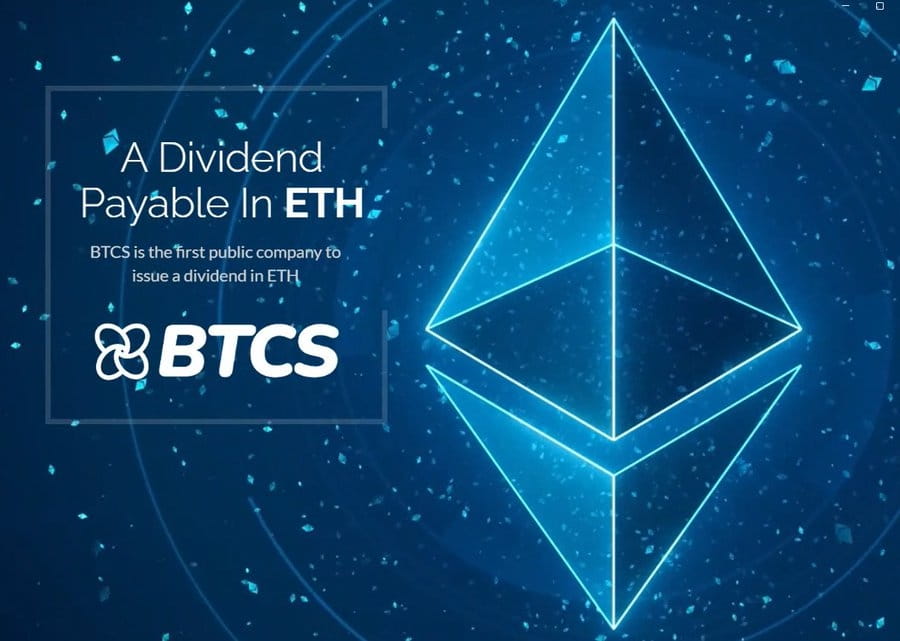In August 2025, the integration of traditional finance and the crypto world welcomed another milestone event. BTCS Inc., a blockchain infrastructure company listed on Nasdaq (ticker: BTCS), officially announced that it will distribute Ethereum (ETH) dividends to its shareholders, making it the world's first publicly listed company to pay dividends in ETH. This groundbreaking move not only means that shareholders will have the opportunity to directly receive the world's second-largest crypto asset, but also reveals how emerging 'Ethereum treasury companies' like BTCS can manage complex on-chain strategies while holding ETH to achieve continuous asset appreciation.
Killing three birds with one stone

BTCS's launch is not a simple cash dividend alternative, but a carefully designed dual-layer incentive plan aimed at rewarding long-term investors and strengthening its shareholder base.
Basic dividend (Bividend): The company will pay a one-time dividend of $0.05 per share to all eligible shareholders. Shareholders can choose to receive this amount in ETH or cash equivalent.
Loyalty reward: On top of this, BTCS offers an attractive loyalty reward—an additional payment of $0.35 per share. However, this reward can only be received in ETH and comes with specific conditions: shareholders must transfer their BTCS shares to the company's designated transfer agent (Equity Stock Transfer) for book-entry custody during the period from September 26, 2025, to January 26, 2026, and must maintain their holdings during this time. In total, loyal shareholders can receive up to $0.40 worth of Ethereum per share.
It is worth noting that this is not BTCS's first attempt at crypto dividends. As early as 2022, the company launched a 'Bividend' program paying in Bitcoin. However, this Ethereum dividend plan, both in scale and in its complex mechanism combined with loyalty rewards, marks a significant upgrade and demonstrates the company's deep engagement with the Ethereum ecosystem.

Behind BTCS's move is a well-thought-out business strategy. CEO Charles Allen stated that this aims to empower long-term shareholders, allowing them to truly take control of their investments.
First, the most direct purpose is to reward long-term supporters. By establishing loyalty rewards with lock-in conditions, the company can clearly identify and reward investors who have confidence in its future development.
Secondly, this is a clever anti-short strategy. When shareholders transfer shares to a book-entry account, these shares cannot be borrowed for short-selling transactions. This effectively reduces the number of shares available for circulation and short-selling in the market, increasing the operational costs for short-sellers, thereby potentially putting pressure on 'predatory short-sellers' and protecting the stock price from market manipulation.
Finally, this move aims to reshape the market's perception of its value. BTCS pointed out in the announcement that when its board approved the plan, the company's stock price was below its net asset value per share (i.e., the total cash and crypto assets held by the company). By distributing Ethereum dividends, the company not only showcases its large ETH reserves (approximately 70,000 ETH worth over $300 million as of August 2025), but also aims to boost investor confidence and drive the stock price back to its real asset value. The market reacted positively, with BTCS's stock price rising more than 10% after the news was announced.
The BTCS Ethereum dividend event is another strong proof of the integration of crypto assets into mainstream finance. It signifies a profound shift in the positioning of ETH—from a mere 'network fuel' that powers decentralized applications to a core reserve asset and value distribution tool on the balance sheets of publicly listed companies.
Behind this transformation is the increasingly powerful fundamentals of Ethereum. Recently, Ethereum spot ETFs recorded record net inflows, with institutions accelerating their accumulation of ETH. Meanwhile, network activities, such as trading volume on decentralized exchanges (DEX) and the number of daily active wallet addresses, are experiencing explosive growth. More importantly, due to a large amount of ETH being staked, held long-term by institutions, or permanently lost, the supply of ETH on exchanges continues to shrink, creating significant supply tightness.
Under the dual influence of 'growing demand' and 'tightening supply', the value storage and yield-generating attributes of ETH are becoming increasingly prominent, attracting the attention of more and more listed companies.
ETH 'money generating money'

Holding a large amount of ETH is just the first step; how to make these assets 'generate money' is the core competitiveness of companies like BTCS. BTCS has built a diversified value-added flywheel to maximize returns on its ETH assets through the combination of DeFi and TradFi.
Its main strategies include:
Self-staking (Solo Staking): The company leverages its technical advantages to operate Ethereum validator nodes independently. About 38% of its total holdings are used for this purpose, directly earning network security rewards.
DeFi lending and leverage: BTCS deposits about 55% of its ETH into top DeFi lending protocols like Aave. This not only earns interest on deposits but more importantly, they can use this as collateral to borrow stablecoins, then purchase more ETH with these stablecoins, thereby achieving leveraged increases while controlling risk.
Participating in liquid staking ecosystems: The company also joins liquid staking protocols like Rocket Pool as a professional node operator. This not only earns basic staking rewards but also shares additional protocol fees, further enhancing the return rate (this portion accounts for about 6% of its holdings).
Maximizing Extractable Value (MEV): Through its core infrastructure 'Builder+', BTCS employs complex algorithms to optimize block construction and transaction ordering to capture MEV, generating substantial additional revenue for the company. Its Q2 2025 financial report shows remarkable growth in this business segment's revenue.
BTCS is not alone; it is at the forefront of a wave of 'Ethereum treasury companies.' Statistics show that over 70 listed companies or large entities globally have adopted ETH as a strategic reserve, collectively holding over 3% of the total ETH supply. These companies are forming an emerging institutional track, each with its unique approach:
BitMine: As the largest ETH corporate holder in the world, backed by capital giants like Peter Thiel and Tom Lee, its goal is to accumulate 5% of ETH's total supply. The company plans to deeply engage with Ethereum's native protocols in the future through staking and other methods.
Sharp Link Gaming: This former gambling company has made ETH its primary reserve asset and stakes nearly 100% of its holdings through professional service providers like Figment to steadily generate returns.
Bit Digital: Fully transformed from a Bitcoin mining company, it clearly positions itself as a 'public platform focused on asset management and staking strategies native to Ethereum.'
The practices of these companies indicate that incorporating ETH into corporate treasuries is no longer a simple store of value, but an active and complex asset management strategy. They utilize various financial tools such as staking, re-staking, DeFi lending, and derivatives to transform ETH from a static asset into a dynamic asset capable of generating continuous cash flow.
Conclusion
The distribution of the world's first Ethereum dividend by BTCS is undoubtedly a significant milestone in crypto history. It not only provides a new imaginative space for how listed companies can reward shareholders but also proclaims in the most intuitive way: Ethereum is moving from the fringes to the center, evolving from a tool for technologists to a financial asset that Wall Street can trust and use.
As one analyst put it: 'ETH is no longer just a fuel for the network; it is now starting to pay dividends. And this will change everything.' In the future, we may see more companies following suit, marking the quiet dawn of a new era of corporate finance driven by crypto assets.

